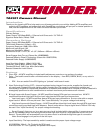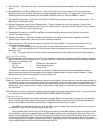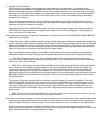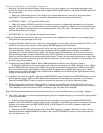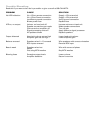5. Gain Control – This feature is used to fine-tune the input sensitivity of the amplifier to the source unit’s output
level.
6. Selectable 80Hz or 120Hz 24dB/oct X-over – This control allows the user to choose one of two low-pass
frequency points the amplifier will play for the best possible performance. The upper end of the crossover
frequency points can be selected from either 80Hz, 24dB per octave or 120Hz at 24dB per octave.
7. ThunderEQ (Switchable)- This feature will add 0 or 12dB of low frequency impact to the audio system. The
Bass Boost is centered at 40Hz.
8. Remote Subwoofer Level Control (Remote Sub) – This port allows the use of the optional “remote level
control”. The Remote Subwoofer Level Control is a bass control module that can be installed in any location
within the vehicle for remote adjustments.
9. StreetWires Connectors – All MTX amplifiers include StreetWires connectors for efficient current and
maximum voltage transfer
10. Speaker Connection – Two sets of speaker terminals are provided for dual woofer applications. When
connecting a single woofer, use only one set of speaker terminals.
11. Power Terminals – This is the main power connection for the amplifier. The power and ground wire size
should be the same gauge.
• GND – The ground wire from this connection must be attached to bare metal on the vehicle.
• REM – To turn the amplifier on/off, this terminal must be connected to the source unit’s “remote or electric
antenna” wire.
• +12V – The power wire from this connection must be attached to the positive side of the vehicle battery.
Before Starting
MTX recommends that you have your new Thunder amplifiers installed by an authorized MTX retailer, preferably
MECP certified. If you do decide to do it yourself, make sure you have read the instructions carefully, and that
you have the following tools:
• Electric drill • Phillips bit or Screwdriver
• 1/8” bit • Wire cutters/crimpers
• Safety Glasses • X-acto Knife
Disconnect the vehicle’s negative battery connection. Any deviation from the recommended connection
procedures may cause serious damage to the amplifier, speakers and/or vehicle electrical system. Please
double-check the connections before turning the system on.
Installation - Mounting
Place your Thunder amplifier at the predetermined mounting location. Using a felt pen, mark the exact position of
the mounting holes on the mounting surface. Set the amplifier aside then with a sharp, precise blade cut small
circles in the carpet and padding around the four marks denoting your mounting holes to expose the metal
underneath. Use a center punch to make an indentation in the metal to ensure that you drill the exact position
for the screws.
Note: Please use common sense and make sure that all vehicle wires, gas lines, break line, etc… are clear and will
not interfere with the installation. ALWAYS WEAR PROPER SAFETY GLASSES.
Connections
1. Bi-Level Inputs (Low/High Level Input) with Smart Engage –Both a low and high-level signal can be used. Be
sure to lay the signal wire away from all power cables and vehicle computers. Use high quality twisted pair
interconnect cables to decrease the possibility of radiated noise entering the system.
• Using RCA Connections: If the source unit has RCA outputs, simply attach a signal cable from source unit
to amps RCA input. This will provide signal to the amp.
• Using Speaker Level Connections: If the source unit does not have RCA outputs, a high level signal can be
used instead by taking the supplied high-level RCA adaptor cables and connecting the bare wire ends to the
vehicle’s rear speakers wiring. Connect the left negative speaker wire to the green with black stripe wire on the
supplied high level RCA adaptor. Connect the left positive speaker wire to the solid green wire. Do the same
for the right speaker connection using the purple wire. Now plug the RCA connectors located on opposite end
of the supplied high-level RCA cables into the amp’s INPUTS.



